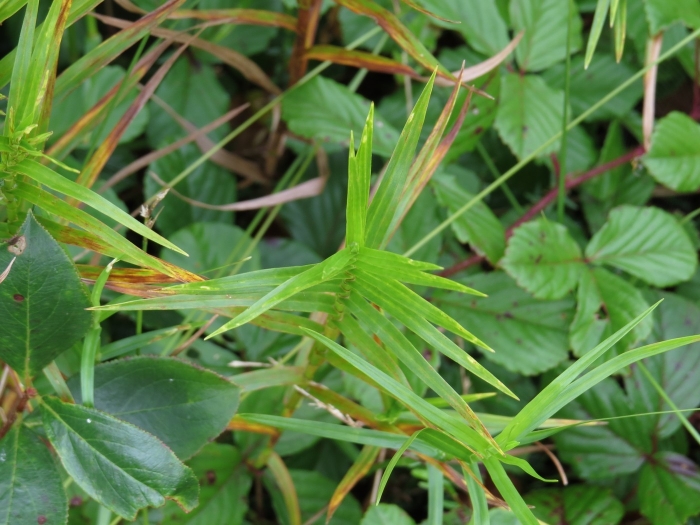Three-Way Sedge
(Dulichium arundinaceum)
Three-Way Sedge (Dulichium arundinaceum)
/
/

Evan M. Raskin
CC BY 4.0
Image By:
Evan M. Raskin
Recorded By:
Copyright:
CC BY 4.0
Copyright Notice:
Photo by: Evan M. Raskin | License Type: CC BY 4.0 | License URL: http://creativecommons.org/licenses/by/4.0/ | Rights Holder: Evan M. Raskin | Publisher: iNaturalist | Date Created: 2018-08-12T16:11:27-07:00 |















































Estimated Native Range
Summary
Dulichium arundinaceum, commonly known as Three-Way Sedge, is a perennial herbaceous plant that resembles a grass and is native to wetlands such as bogs, marshes, and wet meadows in the Eastern United States, Pacific Northwest, and parts of Canada. It can be semi-evergreen, depending on the climate. This plant typically grows to heights of up to 1 meter with a thick rhizome system that allows it to spread and form dense colonies. Its appearance is somewhat bamboo-like with bright green, erect stalks that emerge in large, grassy stands. The stems are round to slightly triangular in cross-section, which is less pronounced than in Cyperus or Carex species, and are hollow. The leaves are arranged in three ranks along the stem when viewed from above, which gives rise to the common name "Three-Way Sedge." The leaves have sheaths that wrap around the stems, and the inflorescence emerges from the leaf axils. The spikelets are generally lance-shaped and measure one to three centimeters long when mature.
Three-Way Sedge is valued for its ability to thrive in wet conditions and is often used in rain gardens, water features, and as a ground cover in moist areas. It provides habitat and food for wildlife and can be used to stabilize soil in erosion-prone areas. In cultivation, it requires high amounts of water and can grow in a range of light conditions from full sun to full shade. It is adaptable to various soil drainage types, from fast to slow. While it is not commonly afflicted by diseases, it can become invasive in ideal wetland conditions, so care should be taken to manage its spread in garden settings.CC BY-SA 4.0
Three-Way Sedge is valued for its ability to thrive in wet conditions and is often used in rain gardens, water features, and as a ground cover in moist areas. It provides habitat and food for wildlife and can be used to stabilize soil in erosion-prone areas. In cultivation, it requires high amounts of water and can grow in a range of light conditions from full sun to full shade. It is adaptable to various soil drainage types, from fast to slow. While it is not commonly afflicted by diseases, it can become invasive in ideal wetland conditions, so care should be taken to manage its spread in garden settings.CC BY-SA 4.0
Plant Description
- Plant Type: Grass
- Height: 1-3 feet
- Width: 0.3-1 feet
- Growth Rate: Moderate
- Flower Color: N/A
- Flowering Season: Summer
- Leaf Retention: Evergreen
Growth Requirements
- Sun: Full Sun, Part Shade, Full Shade
- Water: High
- Drainage: Fast, Medium, Slow
Common Uses
Low Maintenance, Water Garden
Natural Habitat
native to wetlands such as bogs, marshes, and wet meadows in the Eastern United States, Pacific Northwest, and parts of Canada
Other Names
Common Names: Threeway Sedge, Duliche Roseau, Dulichium Roseau, Bambuag
Scientific Names: , Dulichium arundinaceum, Dulichium spathaceum, Cyperus arundinaceus, Dulichium canadense,
GBIF Accepted Name: Dulichium arundinaceum (L.) Britton